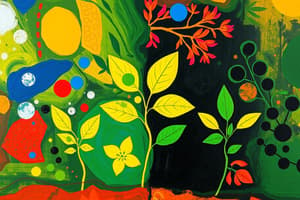Podcast
Questions and Answers
During the light-dependent reactions of photosynthesis, what is the primary role of chlorophyll?
During the light-dependent reactions of photosynthesis, what is the primary role of chlorophyll?
- To transport water to the leaves.
- To split carbon dioxide molecules.
- To synthesize glucose directly.
- To absorb light energy. (correct)
The Calvin cycle (dark reactions) directly utilizes sunlight to convert carbon dioxide into glucose.
The Calvin cycle (dark reactions) directly utilizes sunlight to convert carbon dioxide into glucose.
False (B)
In photosynthesis, what two energy-carrying molecules are produced during the light-dependent reactions that are then used to power the Calvin cycle?
In photosynthesis, what two energy-carrying molecules are produced during the light-dependent reactions that are then used to power the Calvin cycle?
ATP and NADPH
The tiny pores on the surface of a leaf that facilitate gas exchange are called ________.
The tiny pores on the surface of a leaf that facilitate gas exchange are called ________.
Match the following components of photosynthesis with their respective functions:
Match the following components of photosynthesis with their respective functions:
What is the primary function of the vascular bundles (veins) within a leaf?
What is the primary function of the vascular bundles (veins) within a leaf?
C4 plants are more efficient than C3 plants in hot, dry conditions due to their ability to minimize photorespiration.
C4 plants are more efficient than C3 plants in hot, dry conditions due to their ability to minimize photorespiration.
What is the name of the process where light energy is used to create ATP during the light-dependent reactions of photosynthesis?
What is the name of the process where light energy is used to create ATP during the light-dependent reactions of photosynthesis?
In CAM plants, stomata open at _________ to minimize water loss.
In CAM plants, stomata open at _________ to minimize water loss.
Which of the following is the balanced chemical equation that summarizes the process of photosynthesis?
Which of the following is the balanced chemical equation that summarizes the process of photosynthesis?
Cyclic photophosphorylation involves both photosystem I and photosystem II.
Cyclic photophosphorylation involves both photosystem I and photosystem II.
What is the name given to the fluid-filled space surrounding the grana inside the chloroplast, where the Calvin cycle takes place?
What is the name given to the fluid-filled space surrounding the grana inside the chloroplast, where the Calvin cycle takes place?
The first stable product of carbon fixation in C3 plants is a ________-carbon compound.
The first stable product of carbon fixation in C3 plants is a ________-carbon compound.
Match each photosynthetic process with its primary product:
Match each photosynthetic process with its primary product:
What adaptation allows CAM plants to thrive in extremely dry conditions?
What adaptation allows CAM plants to thrive in extremely dry conditions?
Flashcards
Photosynthesis
Photosynthesis
The process where plants, algae, and some bacteria convert sunlight, water, and carbon dioxide into sugars (glucose) and oxygen.
Leaf
Leaf
Flat, broad structure on a plant, designed for maximum sunlight absorption and gas exchange.
Stomata
Stomata
Tiny pores on the leaf surface that allow for gas exchange (CO2 in, O2 out).
Light Reactions
Light Reactions
Signup and view all the flashcards
Chlorophyll
Chlorophyll
Signup and view all the flashcards
Grana
Grana
Signup and view all the flashcards
Stroma
Stroma
Signup and view all the flashcards
Photophosphorylation
Photophosphorylation
Signup and view all the flashcards
Cyclic Photophosphorylation
Cyclic Photophosphorylation
Signup and view all the flashcards
Non-cyclic Photophosphorylation
Non-cyclic Photophosphorylation
Signup and view all the flashcards
Dark Reactions (Calvin Cycle)
Dark Reactions (Calvin Cycle)
Signup and view all the flashcards
C3 Plants
C3 Plants
Signup and view all the flashcards
C4 Plants
C4 Plants
Signup and view all the flashcards
CAM Plants
CAM Plants
Signup and view all the flashcards
Photosynthesis Equation
Photosynthesis Equation
Signup and view all the flashcards
Study Notes
- Photosynthesis is a fundamental process where plants, algae, and some bacteria convert sunlight, water, and carbon dioxide into sugars (glucose), releasing oxygen as a byproduct.
Leaf Structure: Photosynthesis Factory
- The broad, flat shape of a leaf maximizes sunlight absorption.
- Veins (vascular bundles) transport water and nutrients within the leaf.
- The mesophyll layer in the leaf is where most photosynthesis occurs.
- The upper and lower epidermis protect the leaf.
- Stomata (tiny pores) in the leaf allow for gas exchange (CO2 in, O2 out).
Two Phases of Photosynthesis
- Photosynthesis occurs in two main stages: light reactions and dark reactions.
Light Reactions (Light-Dependent Reactions)
- These reactions occur in the thylakoid membranes within the chloroplasts.
- Sunlight is absorbed by chlorophyll pigments.
- Chlorophyll pigments absorb different wavelengths of light (chlorophyll a and chlorophyll b).
- The absorption spectra shows how much each pigment absorbs
- Light energy splits water molecules, releasing oxygen, protons, and electrons.
- Energy is stored in ATP (adenosine triphosphate) and NADPH (nicotinamide adenine dinucleotide phosphate).
- Thylakoid membranes are stacked into structures called grana, where light reactions happen.
- The fluid-filled space surrounding the grana is the stroma, where dark reactions take place.
- Photophosphorylation is the process of using light energy to create ATP.
- Cyclic photophosphorylation uses photosystem I and only produces ATP.
- Non-cyclic photophosphorylation uses both photosystem I and II, producing ATP, NADPH, and oxygen.
- Cyclic only uses photosystem I.
- Non-cyclic uses photosystem I and II.
Dark Reactions (Light-Independent Reactions or Calvin Cycle)
- These reactions occur in the stroma.
- ATP and NADPH from the light reactions convert carbon dioxide into glucose.
- The Calvin cycle is a series of chemical reactions where CO2 is "fixed" into organic molecules.
- The end product is a 3-carbon sugar that can be used to build glucose and other carbohydrates.
Photosynthetic Pathways: C3, C4, and CAM Plants
- Plants have adapted to different environments, leading to variations in their photosynthetic pathways.
- C3 plants are the most common type where the first stable product of carbon fixation is a 3-carbon compound and are less efficient in hot, dry conditions because of photorespiration.
- C4 plants have adapted to minimize photorespiration, use a different enzyme to initially fix CO2, creating a 4-carbon compound.
- Because of the extra energy needed to transport the CO2 to the bundle sheath cells, the rate of photophosphorylation is less in C4 plants as compared to C3.
- CAM plants (Crassulacean Acid Metabolism) are adapted to extremely dry conditions and open their stomata at night to take in CO2, minimizing water loss.
Chemical Equation of Photosynthesis
- 6CO2 + 6H2O + light energy → C6H12O6 + 6O2
- (Carbon dioxide) + (Water) + (Light energy) → (Glucose) + (Oxygen)
Experiments to Demonstrate Photosynthesis
- Oxygen bubbles from an aquatic plant like Elodea under bright light demonstrate the release of energy.
- Boiling a leaf in alcohol to remove chlorophyll, then staining it with iodine demonstrates the presence of starch, with the iodine turning the starch blue-black.
Significance of Photosynthesis
- Photosynthesis is the primary source of energy for almost all life on Earth.
- Photosynthesis produces the oxygen we breathe.
- Photosynthesis removes carbon dioxide from the atmosphere, helping to regulate climate.
- Photosynthesis serves as the base of nearly all food chains.
Studying That Suits You
Use AI to generate personalized quizzes and flashcards to suit your learning preferences.




